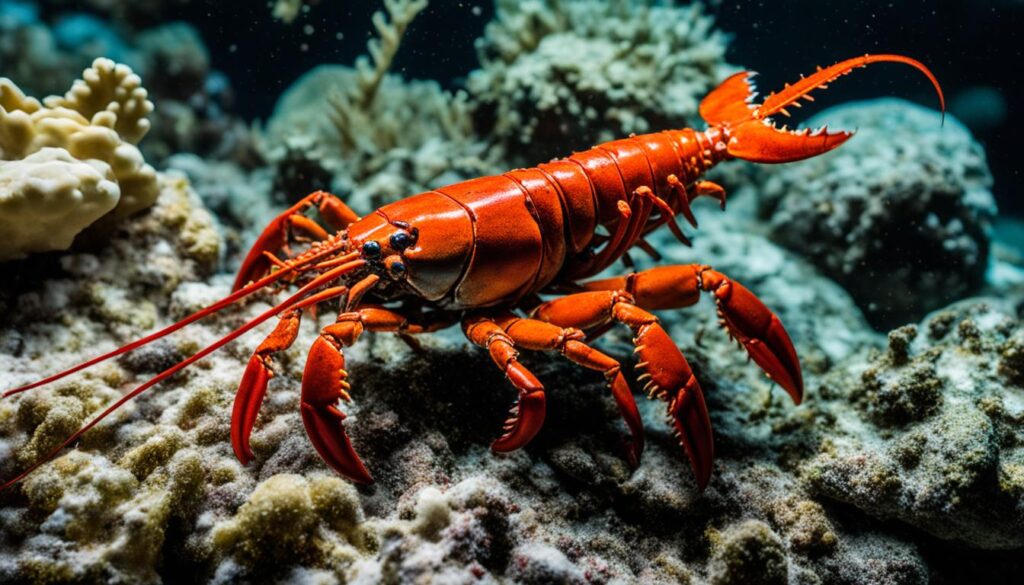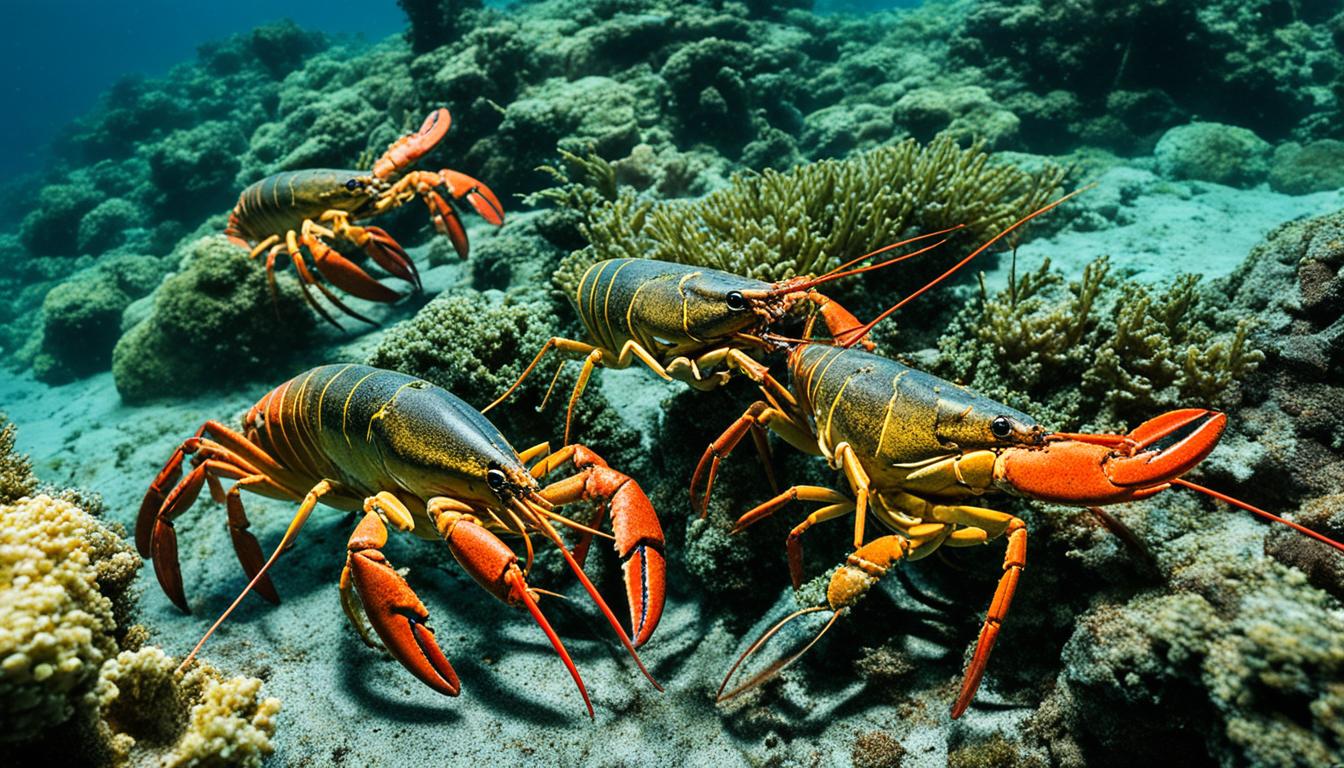Curiosity about lobster defense mechanisms leads you to explore their complex world. It’s important to know how lobsters protect themselves from predators. They use both physical traits and behaviors to stay safe.
You’ll learn about the different ways lobsters defend themselves. From their body shape to how they act, these strategies help them survive underwater. Let’s dive into the unique methods lobsters use to protect themselves.
Understanding Lobster Defense Mechanisms
Lobsters have developed many ways to survive in the tough underwater world. Their lobster defense mechanisms are both physical and behavioral. These help them stay safe from dangers.
Their hard outer shell is a key defense against predators. It keeps them hydrated and safe during low tides. Also, different lobsters have different sized and strong claws, showing how they adapt to defend themselves.
Lobsters use smart behavior to stay safe too. They hide in small spaces or among rocks, blending in with their surroundings. This shows how they use lobster protective strategies to avoid being caught.
Learning about these traits helps us understand lobsters better. It shows how they’ve evolved to deal with threats from predators.
The Role of Claws in Lobster Self Defense
Lobsters have amazing features, especially their claws. These claws are key in hunting and defending themselves. They come in different types, each with its own job to help the lobster survive.
Lobster Crusher and Cutter Claws
The lobster crusher claws are strong and great for crushing hard shells. They help the lobster eat and also protect it from threats. On the other hand, the lobster cutter claws are quick and good at tearing food. Both types are vital for the lobster’s life, helping it to eat and defend itself.
Adapting to Claw Loss
When lobsters lose a claw, it’s a big deal for them. But they can adapt through a process called claw loss adaptation. During molting, they can grow back lost claws, sometimes making new ones better than the old ones. This way, lobsters can keep defending themselves and stay part of the ecosystem.
| Claw Type | Function | Characteristics |
|---|---|---|
| Lobster Crusher | Crushing hard-shelled prey | Strong, robust, powerful |
| Lobster Cutter | Tearing food | Agile, sharp, efficient |
| Regenerated Claw | Restores functionality post-loss | May exceed original claw’s functionality |
How do lobsters defend themselves?
Lobsters have unique ways to survive in the wild. They use various strategies to avoid predators. These include hiding and using their natural colors to blend in.
Adaptive Strategies for Predator Avoidance
Lobsters have many ways to stay safe. They hide in small spaces and rocky areas to avoid predators. They also forage at night, making it harder for predators to find them.
This helps them avoid danger and increases their chances of survival.
Using Camouflage as a Natural Defense
Camouflage is a key part of a lobster’s defense. Each lobster species has its own patterns and colors that match its surroundings. This helps them hide from predators.
By looking like the ocean floor or rocks, lobsters are less likely to be seen. This natural defense is very effective in keeping them safe.
Lobster Defensive Behavior in the Wild
Lobsters have amazing ways to defend themselves in the wild. They often flee from danger to stay safe. This quick move helps them escape and adapt to their home.
For lobster survival in the wild, hiding is key. They find shelter in reefs, rocks, and other places. This not only gives them a safe spot but also helps them hide from predators.
Another way lobsters stay safe is by being still or blending in. This trick works well against predators that rely on sight. Learning about these habits shows how lobsters can live in different ocean areas.

Lobster Protection Strategies against Predators
Lobsters have developed clever ways to avoid predators. They use behaviors like hunting at night and rely on their senses. These strategies show how complex their survival is in the wild.
Nocturnal Foraging and Hiding Spots
Lobsters prefer to hunt at night. This makes them less visible to predators. They use the darkness to their advantage while hunting. They also hide in crevices and spots to stay safe.
This shows how adaptable and smart lobsters are about avoiding danger.
Using Antennae for Sensory Detection
Lobsters use their long antennae to detect things. These antennae can pick up chemical signals and water vibrations. This helps lobsters know when predators are near.
They can then move to safety or get ready to defend themselves. These skills highlight the amazing ways lobsters have adapted to their world.
The Importance of the Lobster’s Exoskeleton
The lobster’s exoskeleton is key to its survival. It acts as a shield against predators and harsh conditions. Made of chitin and calcium carbonate, it’s strong enough to protect the lobster from harm. Without it, lobsters would face a higher risk of injury and being eaten.
The exoskeleton does more than just protect. It’s vital for the lobster’s anatomy. It keeps the lobster’s shape and helps muscles attach, which is important for moving and eating. When lobsters lose parts of their shell, they can grow new ones, showing how crucial it is for their survival.
The lobster exoskeleton is essential for its defense and biology. It’s a critical part of how lobsters live and survive. By understanding its role, we see how anatomy and survival strategies work together. This helps lobsters thrive in their tough marine world.
FAQ
How do lobsters defend themselves from predators?
Lobsters have strong claws, a hard shell, and smart behaviors like hiding and blending in. These help them survive in places full of predators.
What are the main lobster defense mechanisms?
Key defenses include their powerful claws, camouflage, and fleeing or hiding. These help them stay safe.
How do lobsters adapt to losing a claw?
After shedding their skin, lobsters can grow back lost claws. They also adapt by making new claws for different tasks. This way, they can still defend themselves even if hurt.
What role do lobster claws play in their defense?
Lobsters have two claws: one for breaking hard shells and another for tearing. Both are crucial for fighting off predators and finding food.
How do lobsters use camouflage for protection?
They use their natural colors and patterns to blend in. This makes it hard for predators to see them. Each lobster species has its own way of camouflaging.
What behavioral strategies do lobsters use to avoid predators?
They hide in small spaces, use their environment, and hunt at night. These behaviors help them avoid predators and stay alive.
How do lobsters detect potential threats?
They use their long antennae to feel out chemical signals and movements in the water. This helps them spot threats early and act fast.
What protective strategies do lobsters employ against predators?
They hunt at night to avoid being seen and find good hiding spots. These tactics help them survive in the wild.
Why is the lobster’s exoskeleton important?
The exoskeleton protects them from attacks and stress. It also helps them heal from injuries.







